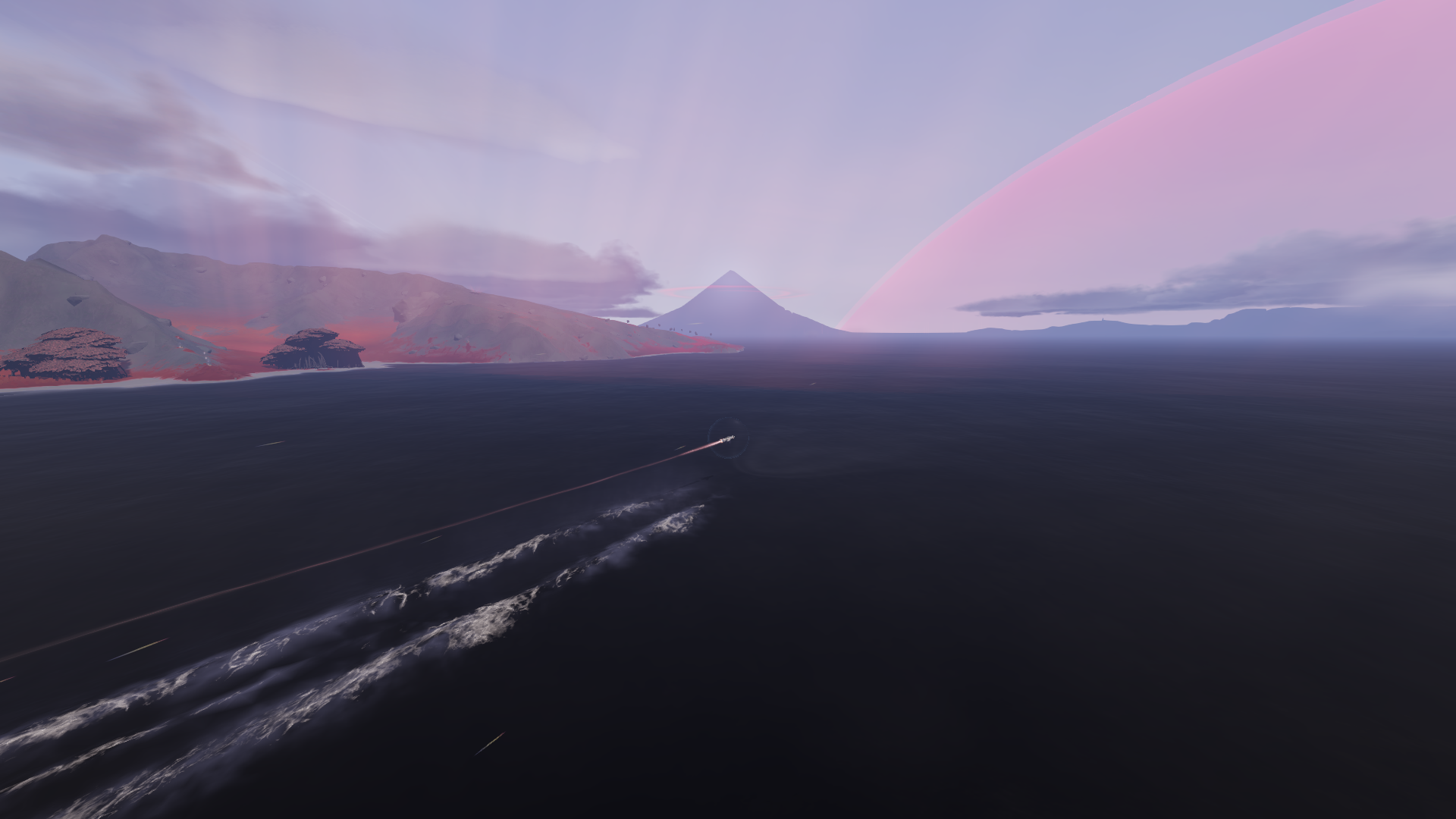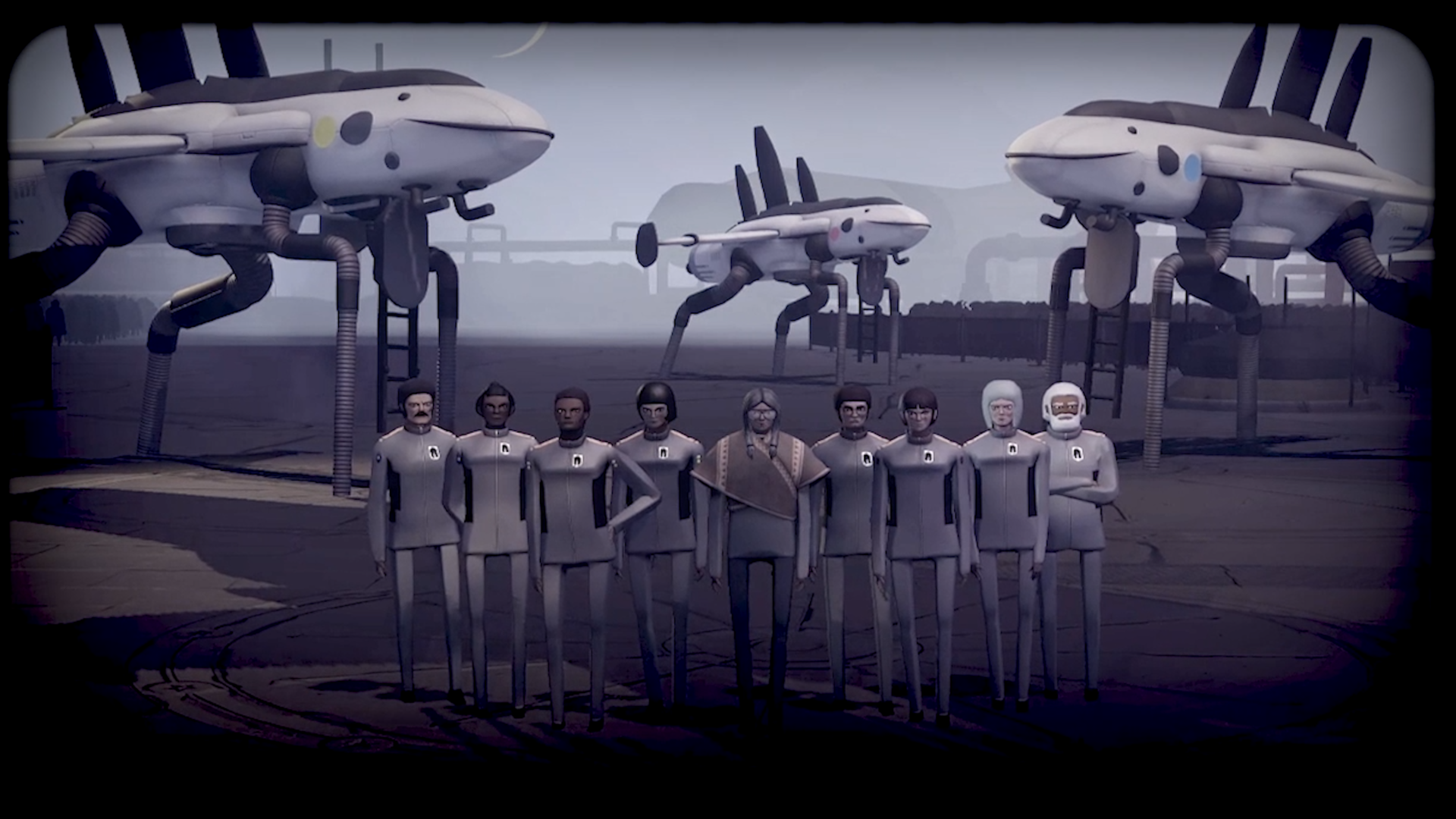
Provided by Superbrothers HQ
Jett: The Far Shore Review-Stark, Beautiful, and Frustrating
In a word, Jett: The Far Shore is sublime. I mean this in the philosophical sense, of something that is so immense, so vast, that its simple existence is enough to make you feel your own smallness. That might seem odd, considering Jett is only about ten hours long, give or take, and was made by a fairly small team in Superbrothers HQ. It doesn’t feature an overwhelming open world, or a slew of complicated mechanics. In fact, it’s relatively simple in how it controls — often to its detriment. But coasting above what appears to be an endless gray ocean as the pink orb of the gloaming hangs above, casting its eerie glow, there is no way to feel but wonderfully, terrifyingly small.

The focus of Jett is a young woman named Mei, a so-called “mystic” and “anchorite” who pilots a small hovering aircraft (the titular jetts) with her co-pilot Isao. The two, along with seven other people from their society, are leaving their dying homeworld to scout out another distant planet written about in documents that serve as a sort of hybrid between science text and scripture. These tsagas detail the “Far Shore” where this culture can rebuild, and the hymnwave, a strange signal that originally called out to their people to explore the Far Shore.
After 1000 years in cryosleep, Mei and her fellow scouts find themselves on this new planet. Thanks to the tsagas, the crew has some idea of what awaits them, but the documents are incomplete and often inconsistent. The team has some idea of landmarks and points of interest, but the flora and fauna of the Far Shore’s gray ocean and rocky islands are a mystery you have to start uncovering. You and your team have four directives from Overseer Jao that you need to complete while on the Far Shore, and it’s implied that you don’t have a ton of time to do so.

This is the meat of Jett’s gameplay. You and Isao navigate around the vast ocean and rocky islands of the Far Shore in your jett, scanning the various lifeforms to catalog them and completing tasks that help get you closer to advancing Jao’s directives. Flying the jett feels incredible when you’re covering large expanses of terrain with no combat or need for more precise piloting. The vehicle flows smoothly, especially across water, and its wide UI allows you to take in the austere beauty of the Far Shore. Unfortunately, you also have to use the jett to solve environmental puzzles and dodge aggressive native life, which requires a level of precision that the controls simply lack.
Because of how hard it can be to pilot the jett in small spaces, or to control its speed while towing something or moving near a creature you’re trying to sneak up on, many of the tasks end up feeling extremely frustrating. Even if you know what the solution for an environmental puzzle should be, that doesn’t mean you’ll be able to execute on it. If you don’t punt something to the exact right spot, or you hit your boost just a bit too hard, you’ll likely have to start what you were doing over again.

The Far Shore is meant to be a harsh place, somewhere you and your party are meant to endure. Its gray ocean is vast, and as you explore it more and more dangers make themselves known. The same goes for the rocky outcroppings generously called islands. From tiny but nasty bugs to giant, flying monsters, and the nightly dose of what I can only assume is something akin to radiation with the gloaming, the Far Shore is not a welcoming place.
But instead of the environment feeling hostile or like something that needs to be survived, it mostly feels like the jett, as your main tool to interact with that environment, just isn’t up to the task. The upgrades it gets are useful, but maneuvering with any type of precision feels clunky at best, which gets incredibly old as the game goes on and you have to juggle more and more environmental factors to progress.

For me, the tension between trying to move the story forward and navigating the environment became extremely grating. I wanted to see what this game had to say about colonizing a new world after destroying your old one, about the connection between faith and science, but actually doing that minute-to-minute felt like a slog in the mid-game. Which is unfortunate given the intriguing threads the game provides narratively, along with the Far Shore’s saturated, wintry colors, haunting soundscapes, and stoic beauty. These elements beg to be explored more, but the gameplay itself throws up roadblock after roadblock. Whether or not you can surmount these will depend on how deeply invested in the narrative you find yourself feeling. Personally, I was intrigued, but not moved overall.
Despite its frustrations, Jett: The Far Shore is visually stunning, and offers plenty to chew on for those who can endure its mechanical shortcomings. It’s likely not a game for everyone, but those who are willing to put up with frustration along the way will find an experience unlike any other we’ve seen this year in The Far Shore’s bleak beauty.





